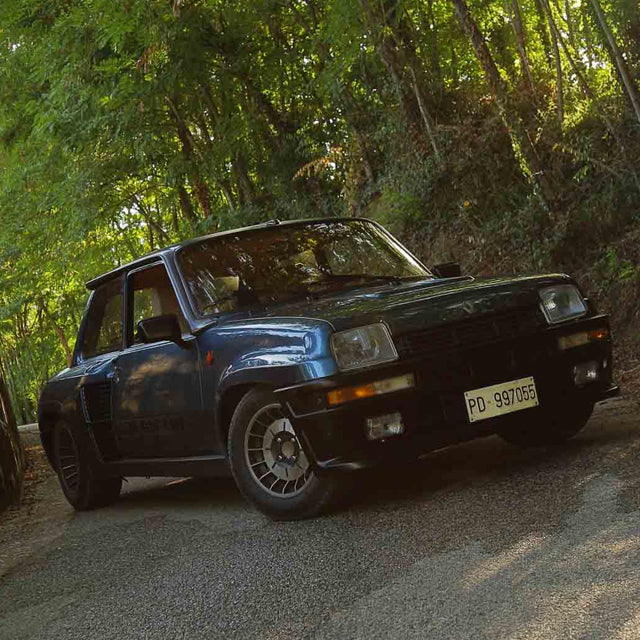Photography by Davide Cironi
This box of pure French hate and petrol smell looks at me with a big smile.
“Some cars just don’t have the right face,” I think to myself while lifting the garage door. All the other Group B cars have a killer look, which makes it easy to understand their cruel intentions—think Lancia Delta S4, 037 or the Audi Quattro. But this one…it smiles.
We watch each other for a long time, in the silence of the morning, hidden in a small, quiet country village in southern Italy. I wonder why and how only 160 horsepower are intimidating me, considering I just came off a Bugatti EB110, for God’s sake. Its fiberglass wide body, gaping air intakes, special turbofan wheels, and racing belts bolted to the back—on the panel that covers the rear-mid-engine—are so unique.
Everything is so racing, I should don my fireproof suit.


Before starting the 4-cylinder turbocharged engine, I remember that it’s not quite the same I experienced many times in a regular 5 GT; here, the exhaust system must not pass under the entire car. The result is an evil, direct sound. I think the whole village heard the first blasts while I was inside watching the rev counter; 1 to 3, then from 3 to 4, waiting for the proper temperature.
Out of the garage, under sunlight, I can see odd tones in its livery. Aging differently, its fiberglass and metal parts are now lighter and darker, once the same color but not now. From the first rotation of its wheels, everything tells me this car is very special and rare.
Rolling through secondary alleys to reach open road, it begins to explain itself: everything is so direct that you have to anticipate your thinking; engine response, steering, right pedal, gearbox, brakes—all of them are driver-oriented. It’s a filthy way to design a driver’s car, because when driving it at low speeds, you start to think it will be easy. There’s no massive push from the engine, no unwanted power slides or back kicks, so you start to feel the urge to drive more quickly. Wrong.



A lack of rear traction and its mid-engine layout are co-conspirators with its very short wheelbase and ’80s Garrett T3 turbo—clues to suggest how dangerous the 5 Turbo actually is. Unluckily, you will not understand that point until it tries to kill you in the very middle of the corner, when you have grown comfortable and confident, thinking: “Hey, my work is to drive things with triple the power every day. This little one can’t make me sweat”. Wrong again.
The exact moment I realize how challenging this blue girl could be, my arms begin to moisten, aided by the engine close to my shoulders and the 42° C heat outside the cockpit. What an incredible rally car for the road, but I can’t stop imagining how mental the full-fat Group B version is…it must be something inhuman.
The more I push, the less I trust it. Controls are all sensitive and precise, the pedals, above all, are the perfect position for heel and toe. Its driving position is funny because from the engine forward, it feels like a common hatchback and really similar to the normal 5. Its gearbox is a lightening through changes, simple and accurate, never questioning the driver’s movements.


You can feel the machine working all around, especially the front…which is pretty much empty. The steering has no filter, and my hands seem to touch the suspension and tires, making corrections directly on them. To make things even more fearsome, its turning angle is ridiculous, the braking power, too. I love these difficulties when I drive an old glory like this, because they make the experience so visceral and real.
There was a corner when I realized the speed was way higher than its braking strength; the rear axle tries to overtake me on every dirty road segment, the engine screams and never ceases to spit flames behind my back, while I’m working like mad inside, sweating and praying in French to find the common sense to slow down.
And then, the fury is over. We’re both home safe. So why do I have the urge to watch some of Jean Ragnotti's Group B footage tonight?
https://www.youtube.com/watch?v=B2HjCrnr-NE



























































